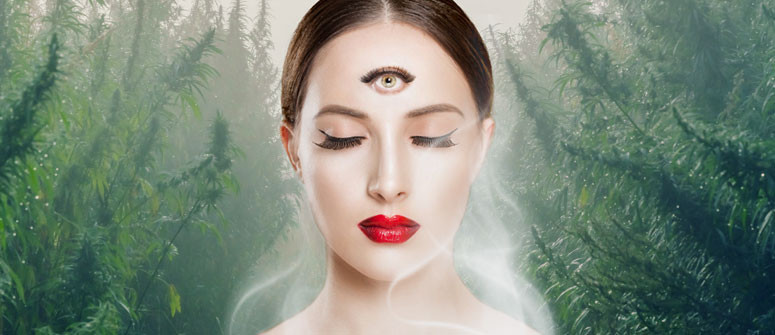Can you open your third eye with cannabis?

Could cannabis be the key to "unlocking" the third eye? Well, it all depends on who you ask. Let's explore the relationship between weed, the pineal gland, and the enigmatic third eye.
The “third eye” is the ancient concept of a kind of lens in the human brain that can help expand our consciousness and our understanding of reality. In many ancient cultures, it represents a key psychic center in the body and the source of enlightenment and wisdom.
Over time, the third eye referenced in chakras and ancient belief systems has been linked to the pineal gland, a tiny, independent gland in the brain which plays a key role in the metabolism of psychoactive drugs like cannabis.
So, could cannabis help you “open” your third eye by stimulating the pineal gland?
UNDERSTANDING THE THIRD EYE
The third eye is a colloquial term used to refer to the pineal gland. The pineal gland is a small, pinecone-shaped endocrine gland found in the brain of vertebrates. It is located in the epithalamus, near the center of the brain, between the left and right hemispheres.
The pineal gland’s main function is to produce melatonin, a hormone derived from serotonin. Melatonin plays a key role in moderating sleep and, in humans and other animals, also helps control our circadian rhythm.
THE PINEAL GLAND IN SOCIETY AND CULTURE
Some animal-based studies also suggest that the pineal gland plays an important role in metabolizing recreational drugs, and has also been the focus of much philosophical discussion.
René Descartes, for example, discussed the pineal gland in his books Treatise of Man and Passions of The Soul. In the latter, he referred to the pineal gland as "the principal seat of the soul and the place in which all our thoughts are formed.”
He also suggested that the pineal gland is what connected the human soul to the body. Descartes was especially drawn to the pineal gland because he believed it was the only part of the brain that functioned on its own rather than as part of the entire organ.
Despite his fascination with the pineal gland, Descartes wasn’t responsible for naming it the “third eye.” Instead, the term is often attributed to fellow French writer Georges Bataille, who first discussed the concept of the “pineal eye.”
Bataille referred to the pineal eye as the center of pleasure and delirium, and a kind of “blind spot” in Western rationality. One of Bataille’s most referenced works on the concept appears in The Pineal Eye, featured in Visions of Excess.[1]
In the late-19th century, Russian author Helena Blavatsky first drew a connection between the pineal gland and the third eye referenced in Hinduism.[2] Hindu beliefs consider the Ajna chakra (or third eye) as one of the 7 main chakras found in the human body.
In Hinduism and other religions, chakras refer to psychic energy centers throughout the body. The Ajna is believed to be located between the eyebrows along the spinal column.[3] Gurus will often touch their students on this chakra during initiation rituals and thereby channel Sushumna (or the end of duality) and the beginning of “oneness.”
References to the third eye have also been found in other cultures besides Hinduism. The Eye of Horus, for example, has been linked to the third eye, with some authors saying it mirrors the placement of the Ajna chakra.[4]
Today, the third eye remains at the center of a lot of discussions about spirituality, meditation, and philosophy. It is often referred to as the source of enlightenment and is the focus of specific meditations.
Research into the pineal gland has led some people to refer to it as a “visual” gland. Rick Strassman, one of the first doctors in the United States to experiment with psychedelic, hallucinogenic, and entheogenic substances, has proposed the idea that the gland can naturally produce DMT (or N,N-Dimethyltryptamine) in the right conditions and thus, can create these powerful feelings of insight and wisdom we associate with “enlightenment.”
Graham Hancock, a British author, has suggested that DMT could be the “lens” of the pineal gland, allowing us to expand our concept of reality and thereby find profound wisdom from its effects.[5]
CANNABIS AND THE PINEAL GLAND

As we mentioned earlier, there is a strong belief by some researchers that the pineal gland plays an important role in metabolizing drugs and psychoactive substances. Rick Strassman was a big believer in this concept.
Strassman worked a lot of with DMT, which he named The Spirit Molecule in his best-selling book. In this book, he writes:
“[The pineal gland] is quite active in synthesizing compounds related to serotonin, an important neurotransmitter in the brain. Neurotransmitters are the chemical messengers allowing communication among individual nerve cells. Most typical psychedelic drugs, such as LSD, mescaline, psilocybin, and DMT are active in brain sites which are also affected by serotonin.”
“Psychedelic drugs, meditational states, spontaneous near-death experiences and other phenomena which may induce stereotypic death/rebirth and paradisal/hellish states act via the pineal gland.”[6]
So, since we know that the pineal gland responds to psychoactive substances, it begs the question; what happens to the gland when we smoke cannabis?
Research on rats has shown that there are cannabinoid receptors inside the pineal gland. In the Journal of Pineal Research, a 2008 article actually described that the rat pineal gland contains its very own endocannabinoid system (made up of CB1 and CB2 receptors).[7]
The activity of these receptors varies, and is at its lowest towards the end of the daylight period. Studies have shown that, in the presence of THC or anandamide (an endocannabinoid that is very similar to THC), melatonin production in the pineal gland increases.[8]
This makes sense; our body naturally produces melatonin in dark periods to signal the end of our circadian cycle and induce feelings of tiredness. Feeling tired and sleepy is a common side effect of consuming cannabis, and has been linked to this increase in melatonin production.
CAN CANNABIS HELP “OPEN” YOUR THIRD EYE?
So, we’ve covered the pineal gland and how cannabis interacts with this intriguing part of the brain. But can cannabis really help “open” your third eye like DMT or other substances?
To be honest, it seems unlikely. While THC is a psychoactive substance, its relationship with the pineal gland is very different to that of DMT or other psychedelic substances.
Sure, cannabis has played a key role in spiritual ceremonies of many ancient cultures. For some, it can also help induce meditative states or altered states of consciousness. However, claiming that cannabis can “open your third eye” and help you achieve enlightenment is a bit of a stretch.
- ^ NYU Tisch, Visions of Excess, retrieved November-29-2018
Link - ^ Blavatsky Theosophy, The Third Eye and The Pineal Gland, retrieved November-29-2018
Link - ^ Wikipedia, Ajna, retrieved November-29-2018
Link - ^ Gaia, How to awaken your third eye, retrieved November-29-2018
Link - ^ Youtube, The secrets of the pineal gland, retrieved November-29-2018
Link - ^ Amazon, DMT: The Spirit Molecule: A Doctors Revolutionary Research into the Biology of Near-Death and Mystical Experiences, retrieved November-29-2018
Link - ^ NCBI, The rat pineal gland comprises an endocannabinoid system., retrieved November-29-2018
Link - ^ Wiley Online Library, Cannabinoids attenuate norepinephrine‐induced melatonin biosynthesis in the rat pineal gland by reducing arylalkylamine N‐acetyltransferase activity without involvement of cannabinoid receptors, retrieved November-29-2018
Link




